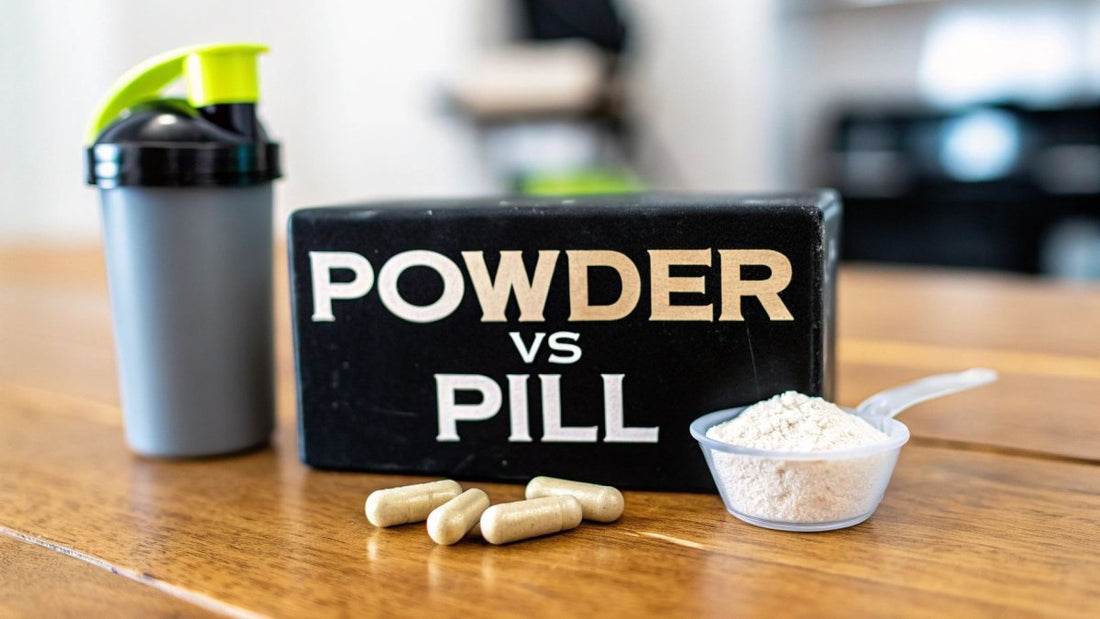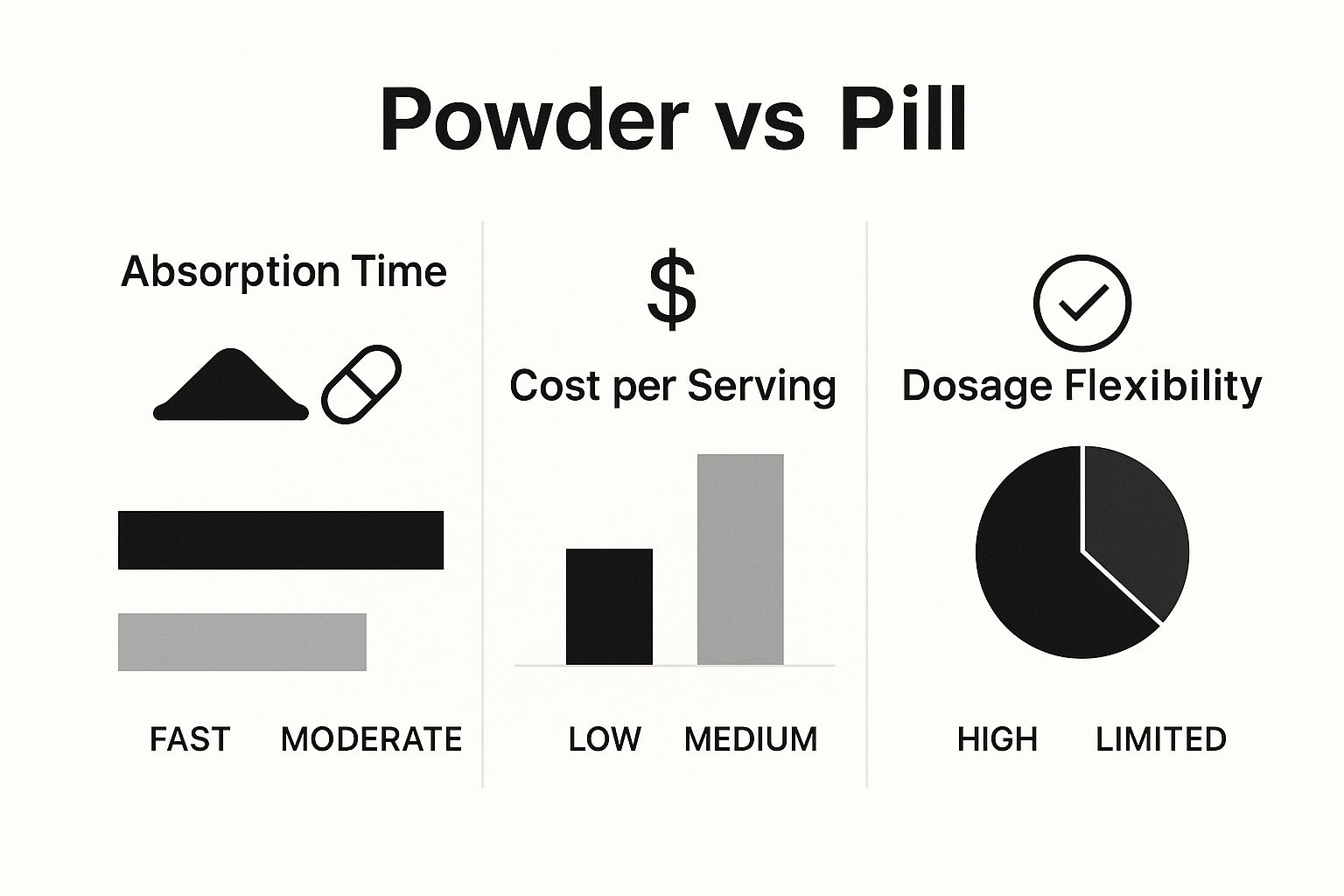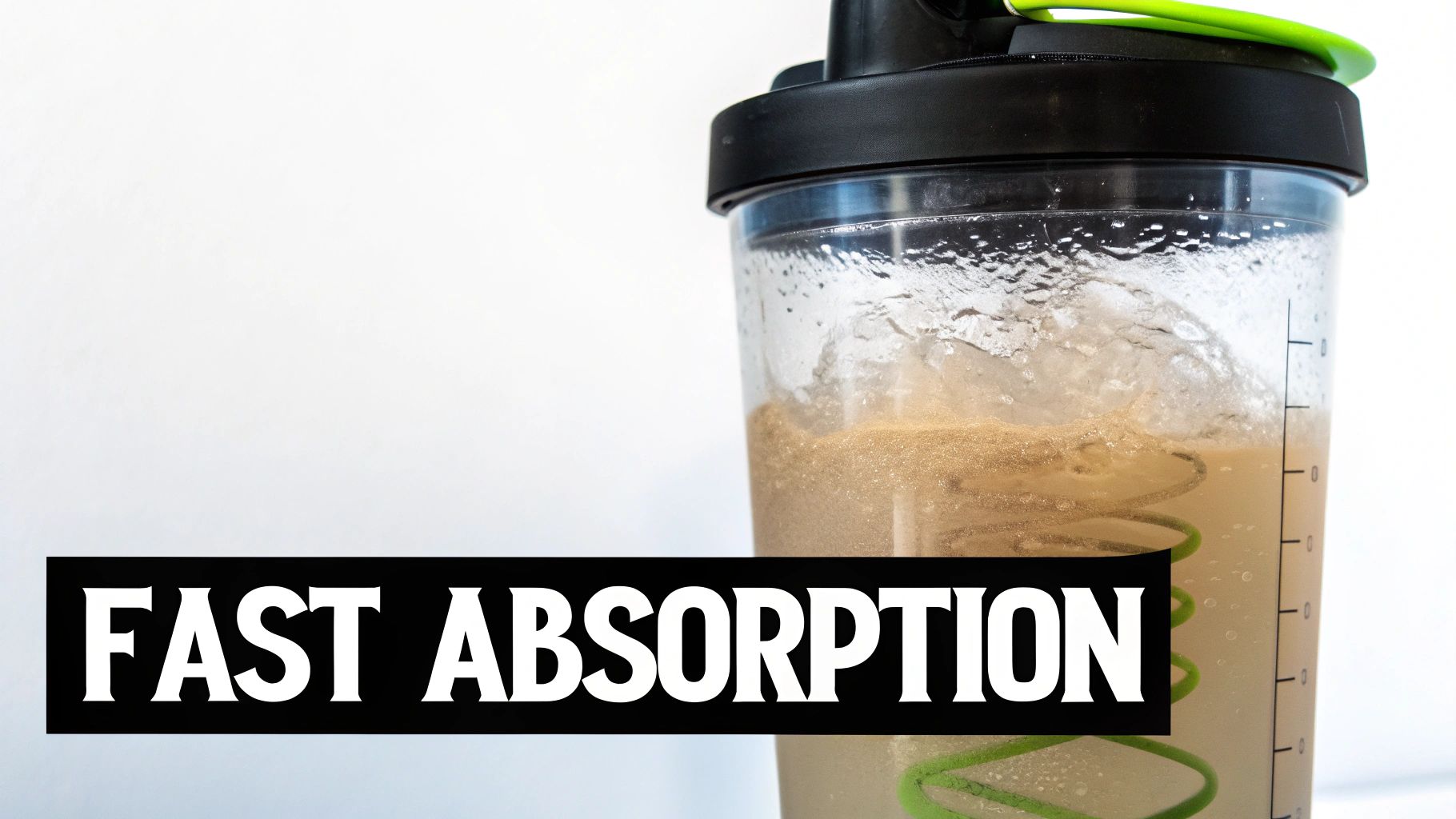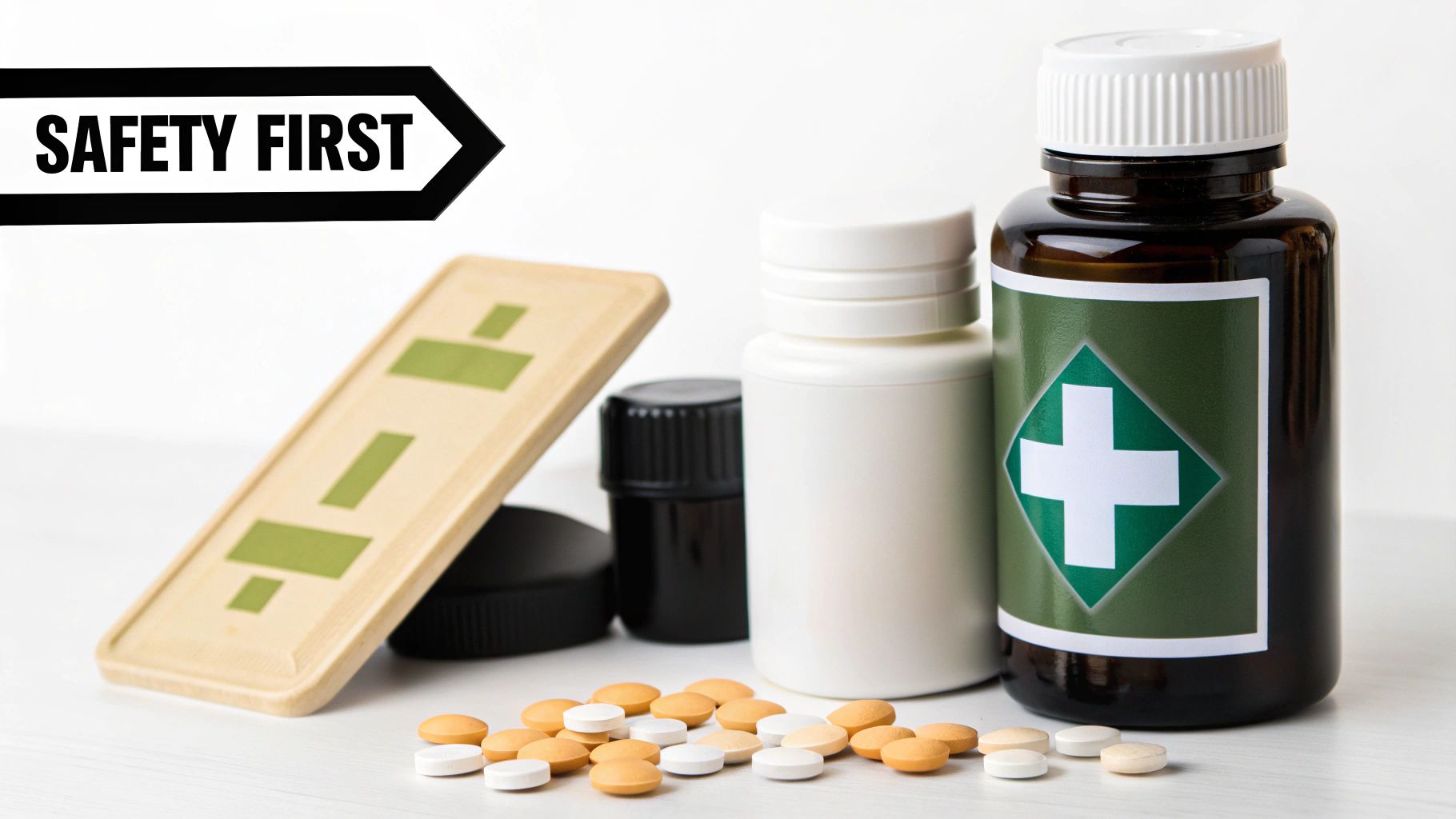
Creatine Powder or Pill Which Is Better for You
Share
When you're standing in the supplement aisle trying to decide between creatine powder or pills, the honest answer is that you can’t really go wrong. Both deliver the same powerhouse ingredient to your muscles. The real question isn't about which one works better, but which one works better for you—your lifestyle, your budget, and your personal preferences.
Powder is the old-school favorite for a reason: it’s typically cheaper and lets you fine-tune your exact dose. On the flip side, pills offer a level of convenience that’s hard to beat, especially if you’re always on the move.
Creatine Powder vs. Pill: A Quick Comparison
Let's get right to it. Even though both forms contain creatine monohydrate, the way you use them couldn't be more different. This isn't a simple "good vs. bad" debate; it's about matching the product to your routine.
To get a clear picture, we'll break down the decision based on what really matters:
- Absorption and Efficacy: Does one form get into your system faster or work better?
- Cost Per Serving: How the price adds up over time.
- Convenience and Usability: Which one fits seamlessly into a packed schedule.
- Dosing Precision: Your ability to dial in the perfect amount for your goals.
This side-by-side visual lays out the main trade-offs in a nutshell.

As you can see, powder clearly wins on cost and dosing flexibility. But when it comes to pure, simple convenience, pills are the undisputed champion.
To give you a clearer starting point, here’s a quick-glance table summarizing the key differences.
Creatine Powder vs. Pill At a Glance
| Factor | Creatine Powder | Creatine Pills |
|---|---|---|
| Cost | Generally lower cost per serving, more budget-friendly. | Higher cost per serving due to manufacturing. |
| Convenience | Requires mixing with liquid, can be messy. | Extremely convenient, easy to take on the go. |
| Dosing | Highly flexible, easy to adjust scoops for loading/maintenance. | Fixed doses, less flexible without taking multiple pills. |
| Taste | Often unflavored but can have a gritty texture. Flavored options are available. | Tasteless and odorless, easy to swallow. |
| Absorption | Dissolves in liquid, allowing for potentially faster absorption. | Needs to be broken down first, might be slightly slower. |
This table should help you quickly see where your priorities might lie.
Ultimately, the choice is deeply personal. If you’re already making a post-workout shake every day, tossing in a scoop of powder is practically effortless. But if you’re a frequent traveler or a busy professional, the grab-and-go simplicity of pills is a game-changer.
Of course, the world of supplements is always evolving. Newer formats have emerged that try to offer the best of both worlds. For example, our guide on creatine gummies vs powder dives into another convenient alternative that’s quickly gaining popularity.
By digging into each of these factors, we’ll give you the framework to choose with confidence, ensuring your creatine supplement truly supports your fitness goals.
How Creatine Actually Fuels Your Muscles

Before you can pick a side in the creatine powder or pill debate, you need to know what this stuff actually does inside your body. Forget the idea that creatine is a stimulant like caffeine. It’s not. Instead, think of it as a high-octane fuel reserve that your muscles tap into for quick, explosive bursts of power.
Essentially, your muscles contract using a molecule called adenosine triphosphate (ATP) as their direct energy currency. Every time you sprint, jump, or push through a heavy set of reps, you’re burning through your readily available ATP. Once it’s gone, your power and performance plummet.
This is where creatine makes all the difference. It acts like an incredibly fast-acting power bank for your muscles.
The ATP Regeneration Cycle
When you supplement with creatine, you increase your body’s stores of a compound called phosphocreatine. Here's how it works: when ATP is used, it loses a phosphate and becomes adenosine diphosphate (ADP)—think of it as a dead battery. Phosphocreatine is the hero of this story, swooping in to donate its own phosphate group back to ADP.
This donation instantly converts ADP back into the high-energy ATP molecule, ready to fuel another powerful muscle contraction. This cycle happens in a split second, allowing you to grind out those extra few reps that truly drive progress. It's the reason you feel stronger and more powerful in the gym.
Key Takeaway: Creatine works by rapidly replenishing the primary energy source (ATP) your muscles use for explosive power, allowing you to train harder and longer before hitting fatigue.
This isn't just gym lore; it's a proven biological mechanism that has made creatine one of the most trusted supplements on the planet.
Market Demand and Popularity
The numbers don't lie. The global creatine market is currently valued at a whopping USD 639.7 million and is growing fast, a testament to its effectiveness. It's not just a trend; it's a staple for athletes everywhere.
Interestingly, powdered forms make up a 58.2% share of that market. This is mainly because people find it easy to customize their dose and believe it absorbs a bit better. With the entire market projected to hit over USD 2.1 billion within the next decade, creatine’s place on the supplement throne is cemented. For a deeper dive, you can check out the full creatine market analysis.
Understanding this science is the key. It helps you realize that the delivery method—whether it’s a powder or a pill—is all about getting this powerful compound into your system efficiently so you can take full advantage of its energy-boosting cycle.
Absorption and Dosing: Where the Real Differences Lie
When you're weighing creatine powder against pills, the conversation almost always turns to two key questions: How well does my body actually absorb it, and can I get the dose right? While both forms deliver the exact same powerhouse ingredient—creatine monohydrate—the way they're packaged creates some practical differences you'll feel in your daily routine.
Is Faster Absorption Really Better?
You’ll often hear that powder absorbs faster. The logic seems solid: you dissolve the powder in liquid, so your stomach gets a ready-to-go solution. Pills, on the other hand, have to be broken down first. The gelatin or vegetable capsule needs to dissolve before your body can even access the creatine inside.
But here’s the thing: that small difference in absorption speed is mostly just theory. In the real world, it’s not likely to make any meaningful impact on your results. Creatine isn’t like a pre-workout that gives you an instant kick. Its magic comes from building up and saturating your muscles over time. A few extra minutes for a capsule to break down won't change your muscle saturation levels in the long run.
Key Insight: The real goal with creatine is consistent, long-term muscle saturation. Tiny differences in how quickly it absorbs won't really move the needle on your performance or muscle growth.
Dosing Precision: The Clear Winner
This is where powder really pulls ahead. For most people, a daily maintenance dose of 3-5 grams is the sweet spot. With powder, getting that exact amount is as easy as putting one level scoop in your shaker. Simple.
This precision becomes even more critical if you decide to do a "loading phase" to saturate your muscles faster. A typical loading protocol involves taking 20 grams a day, usually split into four 5-gram servings. Imagine trying to do that with pills versus a scoop. It’s no contest.
Now, let’s look at the pills. They usually come in fixed doses, like 750mg or 1g per capsule. To hit your daily 5-gram goal, you’d have to swallow five to seven pills. Every. Single. Day.
Let's break that down for a standard 5-gram target:
- Creatine Powder: One scoop. Mix it, drink it. Done.
- Creatine Pills (750mg each): You'd need to take about seven pills just to get close (7 x 750mg = 5.25g). Not only is that a hassle, but it's also less precise.
This inflexibility is a major drawback. What if your coach or a specific plan calls for a slightly different amount, like 4 grams? With pills, you’re stuck. For anyone serious about dialing in their supplement strategy, our creatine dosage guide from beginner to expert results can help you customize your intake—a task that is infinitely easier with powder.
Ultimately, the power to fine-tune your dose down to the gram is a huge advantage that pills just can't match.
The Real Cost Per Serving: Powder vs. Pills

When you're standing in the supplement aisle, it's easy to get swayed by the price tag. A tub of creatine powder and a bottle of pills might look similarly priced, but that’s where the comparison ends. To get the real story, you have to look past the sticker price and calculate the cost per serving.
Let's break it down with a real-world scenario. A typical 500-gram tub of creatine monohydrate powder gives you 100 five-gram servings. Now, take a bottle of creatine capsules priced around the same. It might offer 120 pills, which sounds great until you see each pill is only 750mg. Do the math, and that bottle only contains 24 full five-gram servings.
That’s a huge difference. You could easily end up paying four to five times more for the exact same amount of active ingredient, just to have it in a capsule.
Unpacking the Price Difference
So, why the massive price gap? It has nothing to do with the quality of the creatine. The extra cost comes from the manufacturing process. Turning raw powder into a neat little pill is a lot more work.
The Bottom Line: You're not paying for better creatine; you're paying for convenience. The higher price of pills covers the cost of gelatin or vegetable capsules, specialized machinery, extra labor, and more involved packaging.
This reality is clearly reflected in how people vote with their wallets. The U.S. creatine market, valued at $419.4 million, is overwhelmingly dominated by powder, which accounts for a staggering 80.4% of revenue. This isn't just a budget decision; it’s also about the flexibility that powder offers for dialing in the perfect dose. For a deeper dive, you can explore these creatine market trends and see how consumer behavior shapes the industry.
A Clear Cost-Benefit Analysis
Let’s lay it out as simply as possible.
- Creatine Powder: You’re buying the raw ingredient in bulk. Your money goes directly to the creatine, giving you the lowest possible cost per gram.
- Creatine Pills: A big chunk of what you pay covers manufacturing overhead. The convenience of a pre-measured, tasteless dose comes with a serious financial markup.
If you’re taking creatine consistently, the savings from choosing powder add up fast. Over the course of a year, the difference is substantial. For anyone who wants the most effective supplement for the best possible price, powder is the hands-down winner. It really comes down to a simple choice: pay for the active ingredient or pay for the capsule it comes in.
Choosing Based on Convenience and Lifestyle
Forget the science and cost-per-gram for a moment. The real question is: which creatine will you actually take consistently? This is where the practical, day-to-day differences between powder and pills come into sharp focus, and your lifestyle should be the deciding factor.
For a lot of people, the convenience of pills is impossible to beat. There's no scooping, no shaking, and definitely no chalky residue left on your kitchen counter. Just toss back a few capsules with some water, and you're good to go.
The On-The-Go Athlete vs. The Home Gym User
Let’s look at two typical scenarios. First, picture the busy professional who squeezes in a workout between meetings or right after work. Lugging around a bulky tub of powder and a shaker bottle is a hassle. For this person, a small bottle of creatine pills that fits neatly in a gym bag or desk drawer is the obvious, friction-free choice.
Now, think about the person with a dedicated home gym setup. They’re probably already mixing a post-workout protein shake. Tossing a scoop of creatine powder into that same shaker cup adds maybe five seconds to their routine. In this case, powder just makes sense—it slots right into an existing habit.
Situational Recommendation: If your life is a constant shuffle and portability is your top priority, pills are the clear winner. But if you have a set routine at home, like a daily smoothie or shake, powder will integrate seamlessly.
Ultimately, the choice between creatine powder or pill comes down to which of these routines sounds more like yours.
Tackling Taste and Texture
Another huge lifestyle factor is the sensory experience. Even though most quality creatine powders are unflavored and micronized to dissolve better, some people can’t get past that slightly gritty texture. It’s subtle, but if you have a sensitive palate, it can be a deal-breaker.
Pills completely sidestep this problem. They are tasteless, odorless, and offer a perfectly neutral experience every single time. This is a game-changer for anyone who’s picky about flavors or doesn't want to mess with the taste of their favorite protein shake or morning coffee.
So, which form of creatine is right for you? It really just depends on what you value most. To make it even clearer, find the user profile below that best matches your daily life.
Which Creatine Form Fits Your Lifestyle?
Use this table to find the best creatine form based on your daily routine and priorities.
| User Profile | Recommended Form | Primary Reason |
|---|---|---|
| The Frequent Traveler | Pills | Unmatched portability and no need for mixing tools. |
| The Budget-Conscious Lifter | Powder | The most cost-effective option for long-term use. |
| The Busy Professional | Pills | Grab-and-go convenience fits a packed schedule. |
| The Home-Based Athlete | Powder | Easily added to existing protein shakes or drinks. |
| The Taste-Sensitive User | Pills | Completely tasteless and avoids any gritty texture. |
At the end of the day, the best creatine is the one you don't forget to take. By matching the form to your lifestyle, you set yourself up for the consistency needed to see real results.
Final Verdict: How to Choose the Right Creatine

After weighing all the details, the choice between creatine powder or pills really just boils down to your personal priorities. There’s no single "best" form of creatine—only the one that fits seamlessly into your lifestyle, budget, and daily routine. Let's distill everything we've covered into a simple framework to help you make your decision.
Honestly, it all comes down to what you value most.
Key Takeaway: If your main goals are saving money and having total control over your dosage, creatine powder is the undeniable winner. But if you're looking for ultimate convenience, portability, and a completely tasteless option, then creatine pills are clearly the way to go.
It’s a straightforward trade-off. This distinction should make it easy to pick the form that aligns with what matters to you.
A Hybrid Approach for Ultimate Flexibility
Remember, you don't have to be a purist. Plenty of experienced users adopt a hybrid strategy to get the best of both worlds. For example, you could use the cost-effective powder at home for your morning shake or post-workout drink. Then, keep a small bottle of pills in your gym bag, car, or at your desk for those days you're running around. This approach is brilliant because it combines the economy of powder with the unbeatable convenience of pills, ensuring you never miss a dose.
Why Your Choice Matters More Than Ever
The creatine market is absolutely exploding. Its global size shot up from an estimated USD 1.5 billion to USD 1.68 billion in just a single year. This boom is fueled by athlete endorsements, a growing interest in muscle development, and the fact that it's just easier to find now. With a flood of products on the shelves, picking the form you'll actually stick with is crucial for seeing results. You can read more about the expanding creatine supplement market on GIIRsearch.
This is true for everyone, and it's important to remember that creatine isn't just for bodybuilders. For a closer look at its wide-ranging advantages, our guide on the creatine benefits for women breaks down how it supports muscle, mind, and overall wellness. By understanding your own needs first, you can confidently choose the perfect creatine form to help you crush your goals.
Answering Your Top Creatine Questions
Choosing between creatine powder and pills often brings up a few key questions. Let's clear the air and tackle some of the most common things people ask.
Do Side Effects Differ Between Powder and Pills?
Not really. The potential side effects come from the creatine itself, not how you take it. The most common complaint is minor digestive upset or a bit of bloating.
While it's not a huge difference, this can sometimes be more noticeable with powder if it isn't fully dissolved. Either way, the best way to sidestep this is to drink plenty of water and stick to the proven 3-5 gram daily dose.
Pro Tip: If you have a sensitive stomach, try taking creatine with a small meal. This simple trick often solves any discomfort, whether you're using powder or pills.
Do You Need a Loading Phase with Capsules?
A loading phase—taking about 20 grams a day for the first 5-7 days—is a popular strategy to saturate your muscles with creatine more quickly. It's completely optional, but if you want to do it, stick with powder.
Trying to load with capsules is a non-starter. You'd have to swallow a staggering 20-25 capsules every single day. It's just not practical or cost-effective. If you're going with pills, just skip the loading and start with your daily 3-5 gram maintenance dose from day one.
What’s the Best Liquid to Mix Creatine Powder With?
Plain old water works perfectly fine. For a slight edge, you can mix your powder with a drink that has carbohydrates, like fruit juice. The small insulin response can help shuttle the creatine into your muscles a little more efficiently. Many people find it easiest to just toss it into their post-workout protein shake.
One thing to avoid is mixing it with highly acidic drinks like orange or grapefruit juice, especially if you let it sit for a while. The acid can slowly break down the creatine into creatinine, a useless byproduct, making it less effective.
Ready to skip the mixing and chalky taste altogether? Smash.com offers delicious, high-potency creatine gummies that deliver your full 5g dose on the go. Check out our mess-free alternative at https://smash.com.